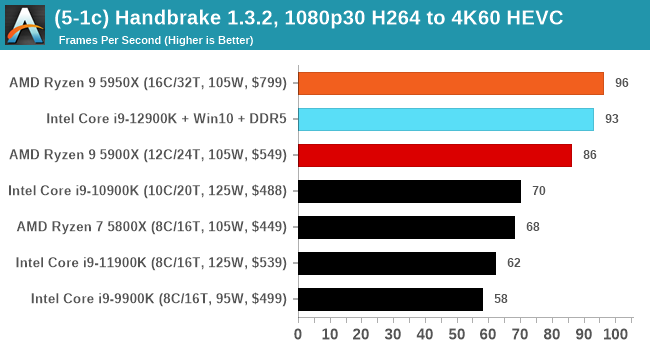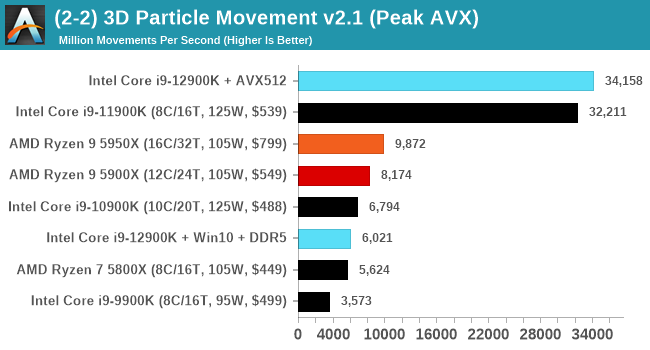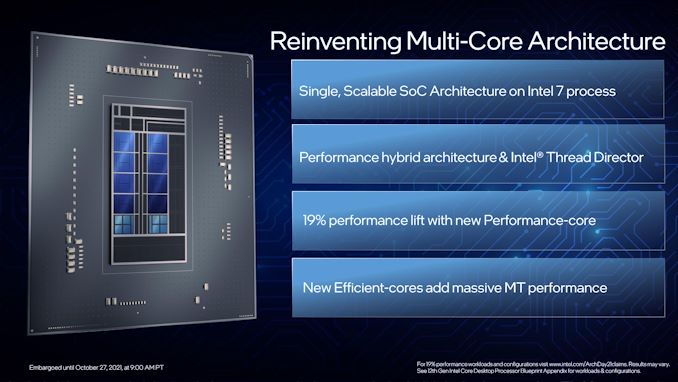The Intel 12th Gen Core i9-12900K Review: Hybrid Performance Brings Hybrid Complexity
by Dr. Ian Cutress & Andrei Frumusanu on November 4, 2021 9:00 AM ESTConclusion: Variables Maketh the CPU
Suffice to say, Intel’s new 12th Generation Core family has added more variables to the mix than a traditional processor launch. The combination of different types of core, coming at a time where a new operating system has just been launched, but also at the inflection point of a new type of memory. Let’s break down some of the differences we’ve observed in our testing.
When we compare Windows 10 to Windows 11, purely on throughput benchmarks, we don’t find much difference. There are a few spots where Windows 11 has a slight advantage in multi-threaded workloads, but this comes down to how new threads are spawned between the performance cores and the efficiency cores. Intel stated that the performance between the two, at least for CPU workloads, should be within a few percentage points, stating that Windows 11 should have lower run-to-run variance. We can corroborate this in our testing. Windows 10 also had some scheduling issues with low priority threads, which we expect to be ironed out with updates.
Comparing the new DDR5 to the old DDR4 is a different story, as the new memory standard offers a substantial uplift when it comes to memory bandwidth. As we saw recently with the M1 Max review, sometimes memory bandwidth can be a limiting factor. In our testing, DDR5 had a minor lead in single threaded tests but in a lot of multithreaded tests, the lead was significant. For real world, we had examples of +14% in Agisoft, +10% in NAMD, +8% in V-Ray, +10% in Handbrake, and +20% in WinRAR. In SPEC2017, we saw a couple of single threaded workloads get +15% improvements over DDR5, but in multi-threaded this was up to +40% on average, or more than 40% in specific tests. This also comes down to the doubled memory channels (4x32-bit vs 2x64-bit) which can be better utilized on top of the bandwidth increases.
Now comparing the P-core to the E-core, and it’s a story of how the E-core individually can perform on par with a Skylake core. Having eight extra Skylake-class cores is nothing to be sniffed at. In a lot of tests the E-core is half the performance of the P-core, but the P-core is itself is now the market leader in performance. The Golden Cove core inside Alder Lake has reclaimed the single-threaded performance crown with an uplift in SPEC of 18-20%, which is in line with Intel’s 19% claim. This puts it ahead of Apple’s M1 Max or 6% (int) and 16% (fp) ahead of AMD’s Zen 3 core.
The Core i9-12900K
Combining fast P-cores, Skylake-class E-cores, and DDR5 into one package means that Intel has certainly jumped from behind the competition to in front of it, or at least in the mix. When you have your operating system set up just right, and no issues with schedulers, it outperforms AMD’s offering when single core performance matters, and in multi-threaded workloads, it does tend to sit somewhere between a 5900X and a 5950X.

It’s important to note that in some tests, the Core i9-12900K does win outright. It’s at this point we should consider how much is core related vs standards related: DDR5 has produced somewhat of an uplift, and the competition is expected to claw some of that back when they introduce it, but those products are expected more towards the latter half of 2022. For users with those specific workloads today, and willing to pay the DDR5 early adopter tax, Alder Lake can provide performance uplifts right now.

Power is an interesting topic, and although our peak power numbers when all cores were loaded were above the 241W Turbo power on the box, in real world workloads it didn’t tend to go that high. The P-cores alone on the chip matched the power consumption of Intel’s 11th Generation in AVX2 workloads, but adding in the E-cores does put it over the previous generation. I’m not entirely sure what that says about Intel’s 7 manufacturing process compared to the 10SF used before. A lot of the performance gains here appear to come from IPC and DDR5, and that doesn’t seem to have come with performance per watt gains on the P-cores. It means that Intel is still losing on power efficiency at load compared to the competition.

I have to say a side word about AVX-512 support, because we found it. If you’re prepared to disable the E-cores, and use specific motherboards, it works. After Intel spent time saying it was fused off, we dug into the story and found it still works for those that need it. It’s going to be interesting to hear how this feature will be discussed by Intel in future.
Overall though, it’s no denying that Intel is now in the thick of it, or if I were to argue, the market leader. The nuances of the hybrid architecture are still nascent, so it will take time to discover where benefits will come, especially when we get to the laptop variants of Alder Lake. At a retail price of around $650, the Core i9-12900K ends up being competitive between the two Ryzen 9 processors, each with their good points. The only serious downside for Intel though is cost of switching to DDR5, and users learning Windows 11. That’s not necessarily on Intel, but it’s a few more hoops than we regularly jump through.











474 Comments
View All Comments
Wrs - Saturday, November 6, 2021 - link
Nah, they just weren't that competitive. Athlon64 was decent (lot of credit to Jim Keller) but didn't let AMD take massive advantage of Intel's weakness during the Pentium 4 era because AMD fabs were capacity limited. Once Conroe came out mid 2006 the margins dried up rapidly and AMD had no good response and suffered a talent exodus. It's true Intel made it worse with exclusivity bonuses, but I think AMD's spiral toward selling their fabs would have happened anyway. No way they were going to catch up with tick-tock and Intel's wallet.GeoffreyA - Monday, November 8, 2021 - link
I've always felt the K10 wasn't aggressive enough, owing to AMD not having factored Conroe into their equations when K10 was designed. Then, like startled folk, they tried to take back the lead by a drastic departure in the form of Bulldozer; and that, as we know, sank them into the ditch. Nonetheless, I'm glad they went through the pain of Bulldozer: Zen wouldn't have been as good otherwise.mode_13h - Tuesday, November 9, 2021 - link
> FX series was as bad as it was for a couple of reasonsI thought I also heard they switched from full-custom layout to ASIC flow (maybe for the sake of APUs?). If so, that definitely left some performance on the table.
bunnyfubbles - Thursday, November 4, 2021 - link
3D v-cache will be out before Zen 4 and should help close the gap if not regain the overall lead on the high end. The problem for AMD is the competition below the i9 vs R9 realm, where the E cores really pull more than their weight and help the i9 compete with the R9s in multi, but for the i5s and i7s vs their R5 and R7 counterparts, its even-Steven with performance cores, then you have the E cores as the trump card.MDD1963 - Thursday, November 4, 2021 - link
If AMD gains an averge of ~10% in gaming FPS with the 3D cache onslaught, that should put them right back near the top...certainly much closer to the 12900K....geoxile - Thursday, November 4, 2021 - link
15% on average. 25% at the highest. Intel really should have offered a 16 P-core die for desktop smdh, classic intel blunderSpunjji - Friday, November 5, 2021 - link
That would be a hell of a large die and necessitate a total redesign of the on-chip fabric. I don't think it would really make any sense at all.RSAUser - Monday, November 8, 2021 - link
12900K is already huge, each performance core is the size of about 4 E cores, going 16C P-Core would probably mean a 70% die size increase, and then you run into core to core communication issues, AMD got around it with infinity fabric but that's why you have the higher latency access between cores in different core complexes and Intel gives a more consistent access time on higher end products. Intel's current cores are mosly ringbus, so travel from one core to the next, getting to 16 doesn't scale well, they used a mesh topology in some Skylake CPU's, that latency was too high and hampered performance badly, you'd run into that same issue with 16C.That's without checking into yield, getting 16C on one wafer that are all perfectly clocking high is going to be a very, very rare chip; AMD gets around it using the core complexes (CX) of 4 cores each, together into a CCD (core chiplet die) and then in Zen 3 (5000 series) is supposedly 8C CCX, which makes rare chips 8C if full ccx works well, else 6C if 2 can't make it turns into a 5600X.
StevoLincolnite - Friday, November 5, 2021 - link
AMD has an answer before Zen 4.And that is Zen 3 with V-Cache.
Spunjji - Friday, November 5, 2021 - link
"This is their Zen 1 moment"Indeed!
"at a lower price"
Not really, if you take platform into account (and you have to!)
"Zen 4 isnt even competing with Alder Lake, Raptor Lake is rumored to be out before Zen 4"
Potentially, but Zen 4 is a bigger jump from Zen 3 than Raptor is predicted to be from Alder. Raptor will have more E cores but it's on the same process, so it's likely to offer better perf/watt in multithreading but unlikely to increase overall performance substantially (unless they allow maximum power draw to increase).
"AMD has really screwed up with their launch cycle"
Not really? They're still competitive in both price/performance (accounting for platform cost) and perf/watt. Zen 3D should shore up that position well enough.
"Intel is truly back"
Yup!